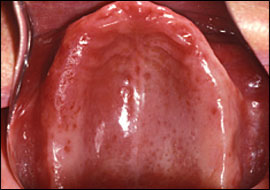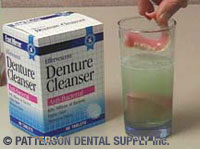How To Clean Denture Cream From Mouth
Having dentures adds a new responsibility to your life. Like how your car requires maintenance throughout the years, your denture does so also. Proper intendance is needed to keep dentures fitting properly and comfortably, and it is your ain responsibility to do and so.
Why maintain your dentures?
Your dental professional should have provided you instructions for the proper care and cleaning of both the dentures and the underlying tissues in the mouth. Intendance of the soft tissues on which a denture rests includes removing the denture overnight or for a substantial time each day, cleaning and massaging the tissues under the denture daily, and going for regular dental examinations to cheque for any irritation or chronic changes in advent of the tissues.
Cleaning and massaging of the soft tissues can be performed simultaneously by brushing with a soft-bristled toothbrush or by massaging with the thumb or forefinger wrapped in a clean fabric.
What happens when yous fail to care for your denture?

Denture Stomatitis © AAFP.org
Failure to remove the denture when you sleep may result in bad breath, excessive resorption of the alveolar ridge (a ridge that forms the borders of the upper and lower jaws and contains the sockets of the teeth), diseased or irritated mouth tissues, or the development of epulis fissuratum.
Consequent, effective cleaning of dentures non only serves to enhance the sense of cleanliness of the rima oris, but besides serves to forestall bad breath, denture stomatitis, and other tissue irritations. Irritation of the mouth soft tissues can lead to difficulties in eating, which can have a negative nutritional impact on a delicate, elderly individual. Ofttimes, denture wearers are merely enlightened of the aesthetic benefits from maintaining cleanliness, which is a wrong mentality to keep.
The surface of a denture has many microscopic pores that attract dental deposits like plaque, tartar and stains, as well as bacterial and fungal organisms. Commonly practiced cleaning methods include immersion, brushing, or a combination of both.
How to clean dentures

Sonic bath © practicon.com
Removal of deposits tin be done by brushing in conjunction with an abrasive amanuensis or brushing a denture earlier and afterward it has soaked in an immersion cleaner. Wrong use of an annoying amanuensis (poor technique and/or too much force per unit area) tin damage the denture. A brush with medium or soft end-rounded beard, if used properly, should not abrade denture materials. A denture brush provides admission to all surfaces of a denture.
Non-abrasive agents such every bit lather or baking soda, or a commercial dentifrice may exist safely used in conjunction with a castor. Other agents may be harmful to denture materials.
Ultrasonic or sonic devices are available for home denture cleaning. They employ a cleaning solution in conjunction with agitation produced by ultrasonic (inaudible, high frequency) or sonic (audible) sound waves to remove debris and stains. Individuals with limited dexterity or for the personal-care staff at long-term care facilities may find the apply of these devices peculiarly helpful. Whichever method is used, the denture should be thoroughly rinsed nether running, lukewarm water before inserting into the mouth in order to remove any substances that could irritate soft tissues.
Using immersion denture cleaners

© smilesonunionsquare.com
There is an reward in immersing the denture in a cleaning solution equally it tin can accomplish all parts of a denture compared to brushing, in which areas of the denture may be missed. Therefore a combination of both brushing and immersion may issue in a more thoroughly cleaned denture. When selecting an immersion cleaner, the type of denture material must be considered. Alcohol or essential oils found in commercial mouthwashes are not compatible with the denture acrylic material, as prolonged contact with these substances may event in the denture becoming dry or lose its color.
Bootleg solutions include using hypochlorite solutions diluted 1:ten with tap water to act as antifungal and antibacterial agents and calculation a teaspoon of calcium-chelating dishwasher detergent to assist control tartar or stains. Care must be taken to not immerse appliances with metallic components in hypochlorite solutions since the metallic surface may corrode. It is important that you thoroughly rinse the bleach off before placement on the oral tissues. Acetic acid (vinegar) can be used for immersion as information technology will kill some organisms and is less caustic to soft tissues if not thoroughly rinsed.
Commercial alkaline metal peroxide powders and denture tablets are too available. These typically contain an alkaline for oxidizing, perborate or carbonate for effervescing, and a chelating agent (EDTA). When dissolved in water, these agents decompose and release oxygen bubbles, which mechanically loosen plaque droppings on the denture surface. The alkaline substances and detergent raise the mechanical event of the bubbling.
Source: https://www.intelligentdental.com/2011/10/29/how-to-clean-dentures/
Posted by: stephanbuturears.blogspot.com


0 Response to "How To Clean Denture Cream From Mouth"
Post a Comment